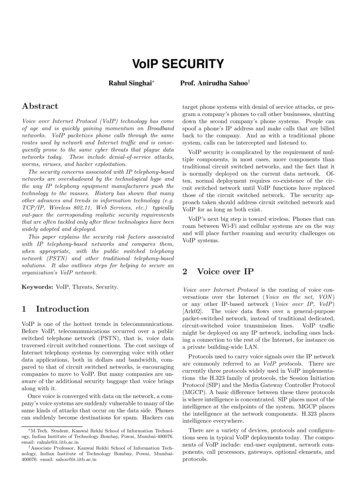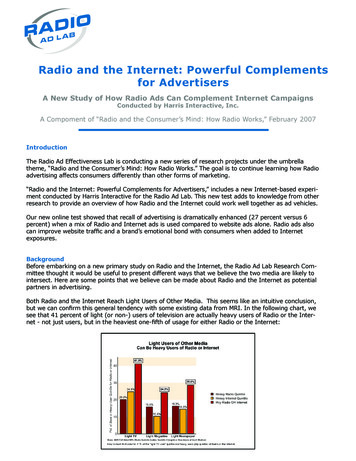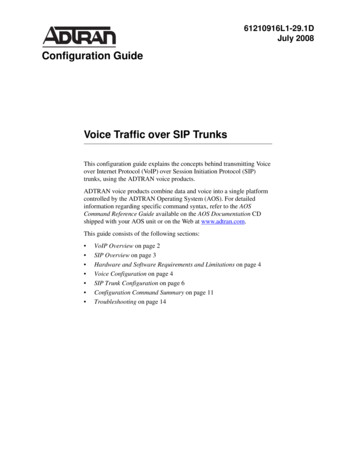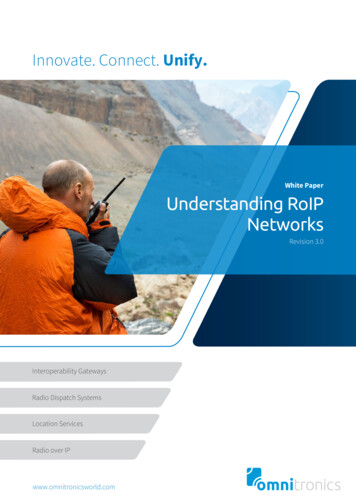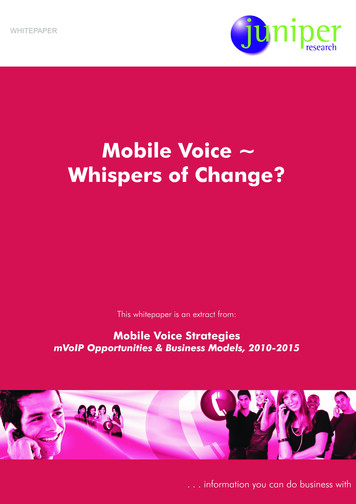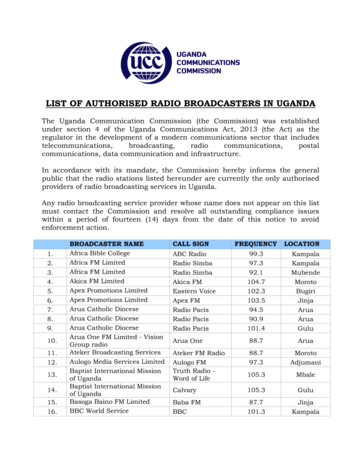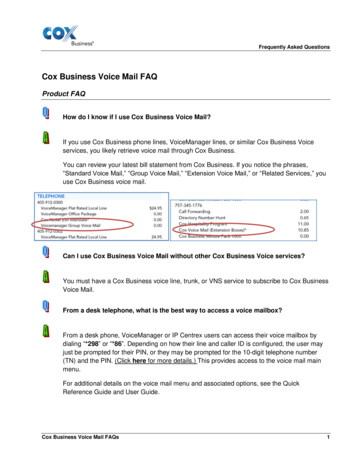
Transcription
5G Voice over New Radio(VoNR)White Paper Version 01.00 Reiner Stuhlfauth
2.32.42.52.5.12.62.72.82.8.12.8.22.8.32.8.3.1Voice call aspects in 5G NR.5Voice services in an NSA dual connectivity setup.7Voice services using EPS fallback.8Network interworking requirements supporting voice services.8Registration procedure – aspects for voice support.105G IMS support.11EPS fallback.17Voice services using NG-N.22Voice services with RAT fallback.23Voice over NR (VoNR).26VoNR radio parameter support recommendation.28Network deployment and connectivity options supporting voice.29Speech codec aspects and EVS.32Supplementary speech services, emergency calls SMS.35Supplementary speech services.35SMS in 5G.36Emergency services in 5G.38Barring methods avoiding network congestion using access category and accessidentity.392.8.3.2 Emergency Services in 5GS.412.8.3.3 Emergency Services fallback (ES-FB).442.8.4 Automotive eCall in 5G.462.8.5 Emergency services over non-3GPP access.482.9Signaling aspects for voice support in 5G.49Rohde & G Voice over New Radio (VoNR)2
1 INTRODUCTIONThe main driver behind the development of 5G networks has always been improved data services:higher mobile data rates and reduced latency, etc. However, the legacy services of voice and videocommunications remain key elements for mobile services, and subscribers continue to demandthem.It is this demand for voice services from mobile subscribers that keeps it part of services providers’packages and business models. However, voice over 5G networks is not just about keeping customers happy; voice also has a role to play in the new data services provided by 5G. According toanalysts, the number of voice subscriptions worldwide will double until 2025 [Ref. 21].While it may seem simple to just keep the voice services that you already have in place, it actuallypresents some thorny technological challenges to accomplish this feat. In fact, a single technicalsolution is not possible because whatever solution is adopted needs to adapt to the existing network deployment.Prior to this latest migration of voice over 5G networks (5G Voice over New Radio (5G VoNR)), themigration of voice services from 3G and circuit switched mobile networks to the 4G Long-TermEvolution (LTE) network was initially slowed by technical challenges. Part of the ability of Voiceover LTE (VoLTE) to overcome its early technical challenges was the fact that it was based on the IPMultimedia Subsystem (IMS) architecture. In a sense, you can track the adoption of IMS by serviceproviders to the rise of VoLTE.This IMS architecture will play an increasingly important role in 5G VoNR. Like 4G LTE networks,5G voice calls are implemented as end-to-end Voice over IP (VoIP) connections managed by theIMS core. Voice and video communication services in these networks ride on top of the IP dataconnection. Unlike voice services provided by external applications (i.e. so-called OTT speech services), voice over IMS supports Quality of Service (QoS) management across the entire 5G System(5GS).While IMS can provide voice services for any type of access (fixed, cable, and 2G/3G) as well as forany 5G-deployment model, 5G is not as flexible and absolutely has to have an IMS network to handle voice services no matter the type of deployment. Just as we could track the adoption of IMS tothe rise of VoLTE, the introduction of 5G serves as a catalyst to accelerate voice core modernizationto IMS from older technologies in networks.As we said previously, a single technical approach to 5G VoNR is not possible. This white paperwill go into detail for all the approaches that can be taken. In general, however, VoNR has to adaptto the existing deployment modes: Non-Standalone (NSA) or Standalone (SA).The NSA deployment mode, known as option 3, involves LTE plus NR with an Evolved Packet Core(EPC). In contrast, the SA deployment involves NR with 5G Core (5GC). This deployment mode isknown as option 2.Once it has been determined whether the RAT is 5G NR or EUTRA, it’s necessary to know if theseare co-existing SA networks or in a dual connectivity scenario: E-UTRAN New Radio–Dual Connectivity (EN-DC) or NR-E-UTRA Dual Connectivity (NE-DC). Of course, you also need to know whetherthe RAT even supports voice services.Rohde & Schwarz5G Voice over New Radio (VoNR)3
Most recent 5G deployments have employed what’s known as the option 3. This approach essentially means that the network providers have an existing 4G LTE network and they have deployed a5G network along side it. In this way, the 5G NR serves as a secondary cell, and the core technology remains Evolved Packet Core (EPC).In the operation of option 3, the UE registers to the IMS over Evolved Packet System (EPS). Whenthe 5G UE launches (or receives) a voice call, this follows typical VoLTE procedures over the EPSsystem.When a service provider can choose option 2, they deploy the 5G network as a SA network, without relying on any other network. In this option, the IMS core provides voice as a 5G-applicationservice. Voice services on this kind of network are referred to as Voice over New Radio (VoNR).Even this option 2 presents challenges. In these early years of 5G, geographic coverage for 5G willbe incomplete. As a result, when a mobile device moves out of a 5G NR coverage area, a VoNRvoice call in progress would need to handover to use the VoLTE in a 4G network. Meticulous network planning and coverage considerations is needed.In the previous VoLTE systems, circuit-switched fallback (CSFB) led to delays causing an interruption to the call. A procedure that will be explained in detail in this whitepaper is the “EPS fallbackfor IMS voice”. This procedure avoids these dropped calls by directing the UE to fall back to theEPS at the start of any voice call as soon as it is launched. Basically, the EPS fallback performs thehandover when the call is first setup instead of during the call and thereby does not impact theuser’s in-call experience. With EPS fallback, the UE will camp on the higher prioritized 5G RAT.There is no need for full support of 5GC yet, thus EPS is a kind of interim step speeding up the timeto market approach for voice services.The benefit of 5G VoNR for voice-only calls is surely the quality and ultra-high definition of thecalls. But, as we pointed out earlier, and perhaps more importantly, 5G VoNR also has an importantrole to play in the new data services provided by 5G.5G VoNR provides a point of integration with applications and content such as announcements,music, conferencing and more. It will also provide enhanced support for real-time communicationsincluding Rich Communications Services (RCS) integration. An example of this RCS integration,we can envision the 5G VoNR will enable interactive capabilities, such as real-time languagetranslations. Many of the more advanced functions will work only in a 5GNR environment with thesupport of 5GC infrastructure.This White Paper will provide in-depth guidance in navigating 5G VoNR from the network deployment and the connectivity options aimed at not only supporting voice over NR, but also ensuringthe data services that VoNR should enable. At the end of the White Paper, a brief summary isprovided on the signaling parameters for both the network and UE side. A general introduction into5G fundamentals, procedures, system and service aspects and technology drivers can be found inRef. 20.Rohde & Schwarz5G Voice over New Radio (VoNR)4
2 VOICE CALL ASPECTS IN 5G NRAlthough data services in the context of enhanced mobile broadband (eMBB), ultra-reliable andlow latency communications (URLLC) and massive machine-type communications (mMTC) arethe pivotal drivers behind the 5G evolution, legacy services like voice and video communicationsstill represent important services that operators want to offer to their subscribers. As part of thetechnology evolution, we have seen a major change from circuit-switched 2G networks with aninitial focus on telephony to fully packet-switched 4G networks focused on Internet data communications.This white paper elaborates the technological details on how a 5G network may support voiceservices. Unfortunately, a single technical solution in the 5G system will not be offered for voiceservices including the radio access technology, infrastructure deployment and protocol layers involved. The objective here is to describe those technical evolution steps intended to support voiceservices to guarantee that those services will not be curtailed due to the introduction of 5G.From a high-level perspective, voice over NR needs to adapt to the existing deployment, whether itis NSA or SA mode and whether the EPC is the core network or the 5GC. The type of voice supportin 5G depends on the available Radio Access Technology (RAT) in the form of 5G NR or EUTRA andwhether both are used either as coexisting standalone networks or in a dual connectivity scenarioEN-DC or NE-DC, and obviously which RAT supports voice services. The second question influencing the type of voice service is the availability of a core network (either EPC or 5GC) and again,obviously, which core network supports voice services.The objective of this white paper is to present the various voice services in 5G in greater detailalong with some evolution paths illustrating how the offered voice services may change with theevolution of the 5G System (5GS), 5G Access Network (5G-AN) and User Equipment (UE) deployment, and lastly, some supplementary services that are supported such as the emergency service,SMS or the automotive emergency service eCall.From a high-level perspective, voice over NR is voice over IP using the IP Multimedia Subsystem(IMS) infrastructure. The advantage of using IMS is the ability to set up and guarantee a Quality ofService (QoS) for each application. The task for IMS is to establish, control and maintain a ProtocolData Unit (PDU) session, including all relevant data bearers with corresponding QoS flow for bestend-user quality experience. One difference compared to a data PDU session in 5G is that with theNon-Access Stratum (NAS) signaling procedure PDU session establishment request, the UE requests a PDU session for IMS signalling. Like in Voice over Long-Term Evolution (VoLTE), voice overIMS in 5GS also supports QoS as a major difference compared to voice services offered by externalapplications, e.g. so-called over-the-top (OTT) speech services.Thus, one question arises concerning how to connect IMS to the next generation network, 5GC.The evolutionary paths describe whether in an NSA connection, voice will be supported by EUTRAonly and if the simultaneous NR data connection can be sustained or will be suspended. Thisoption is referred to as voice over LTE (VoLTE) in EN-DC setup.Rohde & Schwarz5G Voice over New Radio (VoNR)5
The Evolved Packet System (EPS) fallback use case describes the situation where 5GC does notoffer voice services; if necessary, the connection will be handed over to an EPS connection (VoLTE).Another fallback mode is RAT fallback, assuming the current core network supports voice servicebut the current RAT, presumably NR, does not. In that case, the connection is transferred from NRto EUTRA only.Voice over NR (VoNR) indicates the case where the NR network does support voice services andthe 5GC offers a connection to IMS. In general, VoNR is independent of the dual connectivity andthus, it would work with EN-DC, but the focus is on the NR SA where 5GC connects to IMS supporting voice services. Since LTE is considered here to operate in parallel, inter-system handoversare mandatory to guarantee UE mobility and avoid call drops and leverage high-quality Key Performance Indicators (KPIs). Note that in 3GPP Release 15, there is no handover defined between 5Gand 3G/2G. Thus, no Circuit-Switched Fallback (CSFB) scenario is possible either. A handover tocircuit-switched 2G/3G is only possible in two steps via an interim connection to 4G. In 3GPP Release 16, a Single-Radio Voice Call Continuity (SRVCC) is introduced where a VoNR connection canbe transferred to 3G. The objective is to avoid call drops when coverage of 5G services is gettingweaker and LTE coverage is not available. See Fig. 1 for relevant setups.Besides the terminal capabilities, support for voice services in 5G NR needs to consider the variousnetwork deployment options. Critical questions are e.g. which RAT to use, EUTRA or NR, whichcore network is available, EPC or 5GC, and whether the Evolved NodeB (eNB) is an next generationevolved NodeB (NG-eNB) or just a legacy eNB. Consequently, we may speak about EPS fallback,RAT fallback, voice over NG-eNB (NGEN-DC) or standalone VoNR. For sure, the frequency bandallocation accompanies such voice call deployment options, i.e. network operators plan to re-farmlegacy frequency bands in the lower frequencies from LTE to 5G. With such enhanced coverage,services like VoNR also become feasible.Figure 1: Deployment scenarios supporting voice in 5G.Rohde & Schwarz5G Voice over New Radio (VoNR)6
Besides the technology evolution from 4G to 5G on both RAT and the core network, especially forvoice services we see an evolution towards the introduction of more and more sophisticated andhigh-quality voice and video services. One term that accompanies VoNR is the enhanced voiceservice (EVS) with wider audio bandwidth, higher sampling ratio, better quantization and higherresolution. The EVS speech coder has been introduced with LTE in several networks already, but 5Gvoice services rely on this advanced speech coding algorithm more extensively. A concise introduction to EVS with the corresponding speech codec principles is given as well.Due to the N3IWF interworking, there is even an option to establish a voice call over IMS on a non3GPP access network (e.g. WLAN) and handover to VoNR. For the sake of brevity, the details ofthis procedure are omitted here, but they can be found in TS 23.502.A popular derivate of emergency services in the automotive sector known as eCall may operateon LTE as a next-generation eCall (NGeCall), but there is also ongoing research into how to enablefuture-proof emergency call services over 5G NR.2.1 Voice services in an NSA dual connectivity setupRecent deployments of 5G reveal widespread usage of option 3 as one option in the connectivityscenario background in the infrastructure evolution. As a result, EN-DC, where there are two radiolinks, EUTRA and 5G are offered. To accelerate the introduction of voice services, the major aspectof this method is that NR does not support voice services at all since this will be covered by LTE.The criterion in EN-DC mode is that NR cannot exist standalone; thus, LTE coverage is the prerequisite. Operators who have deployed VoLTE for 4G can continue to use IMS services over EUTRAN(partially or fully upgraded to EN-DC). There is no impact on IMS. In fact, the IMS system is noteven aware of the EUTRAN upgrade to EN-DC. All location information exposed to IMS is based onLTE, as before.All VoLTE principles remain applicable. A PDN connection to the IMS (Access Point Name (APN) isused for Session Initiation Protocol (SIP) signaling (on the default bearer with QoS Class Identifier(QCI) 5) and for voice media (on a dedicated bearer with QCI 1. [Ref. 1]The prerequisite for voice services is support for IMS, which is already the case in EN-DC sincethe EPC is connected to IMS already. A possible recommendation includes setup of an IMS PacketData Network (PDN) connection for Session Initiation Protocol (SIP) signaling messages inheritingthe LTE QoS profile QCI 5 and a parallel PDN connection for the voice content inheriting QCI 1 as this is already recommended for VoLTE. Since the setup supports dual connectivity, a thirdPDN default bearer with suggested QCI 9 can now operate as a split bearer to provide additionalpacket data over EUTRA and NR radio interfaces. It would be up to the network implementationand UE maturity whether the NR link is suspended or maintained simultaneously to the EUTRAbearer. This proposal presents an early implementation and support for voice services when deploying 5G since it reuses investments operators made into their LTE network. Bit rate and latencyrequirements are well satisfied over LTE. In a longer-term rollout perspective, EN-DC option 3 maypresent an interim stage that extends the existing EPS by a concurrent 5GC deployment and thenallows the support for VoNR.The challenge as well as a minor drawback involves providing reliable voice services on earlystandalone NR deployments since a common scenario uses middle bands for 5G and lower bandsfor LTE, which may induce some coverage limitations. Another negative aspect is the higher energyor battery consumption since the UE needs to operate on two radio connections simultaneously.[Ref. 1] suggests RAN features such as RLC unacknowledged mode, Transmission Time IntervalRohde & Schwarz5G Voice over New Radio (VoNR)7
(TTI) bundling, Robust Header Compression (RoHC) enabled, etc. that should increase the serviceKPI with optimized quality of experience.Figure 2: Deployment scenario EN-DC supporting VoLTE and Internet split bearer NR LTE.2.2 Voice services using EPS fallback2.2.1 Network interworking requirements supporting voice servicesRegardless of whether 5G deployment is based on NSA or SA mode, the lesson has been learnedfrom legacy network introductions that initial deployments will not have full coverage. Consequently, 5GC needs to be tightly coupled to EPC, especially to an existing IMS VoLTE supportinginfrastructure to provide seamless voice services across the entire network with acceptable Qualityof Experience (QoE) as KPIs. The objective is to register the UE primarily in the 5G network, evenif voice services are not supported and a handover to LTE would be required. This method is RATagnostic and the IMS support for voice services is available via the EPC. A UE camping on NR willthen be redirected to EPC as core and the serving RAT may change from NR to EUTRA as well.Note that a fallback procedure where only the RAT is changed from NR to EUTRA is called voiceservices with RAT fallback. This is further described in section 2.2.3. To leverage this motivationof tight coupling between EPC and 5GC, the objective is first to introduce an additional interfacebetween the core network entities and functions. Note that their implementation depends on thedeployment strategy of operators and infrastructure vendors. A few of these new connectionsinclude: N6 interface to connect the 5GC function User Plane Function (UPF) to the IMS. TS 23.501defines N6 generally as the reference point between the UPF and a data network. For voicesupport, this data network is now represented by the IMS signaling system. A PDU connectioncan be established with the required QoS flow for voice services. N6 is also the prerequisite forfull VoNR supportRohde & Schwarz5G Voice over New Radio (VoNR)8
S5 interface for control and user plane connection between Session Management Function(SMF) / UPF representing the 5GC entities and the Serving Gateway (SGW) representing theEPC entity. From the EPC point of view, the S5-U interface replaces the Public Data NetworkGateway (PGW) for voice services as they are now logically established via the UPF N26 interworking interface between Mobility Management Entity (MME) and Access & Mobility Management Function (AMF) to enable context transfer and network-controlled mobilityscenarios like handover between LTE and 5G. N26 represents an optional network deployment,but as the main advantage, TS 23.501 indicates that interworking procedures with N26 provideIP address continuity on inter-system mobility to UEs that support 5GC Non-Access Stratum(NAS) and EPC NAS and that operate in single registration mode. Without the N26 interfaceand assuming a UE in single registration mode, the control coordination between MME andAMF needs to be routed via SMF and PGW Home Subscriber Server (HSS) interworking with Unified Data Management (UDM), providinga connection to IMS and supporting the querying of the serving AMF when requested by IMS(see TS 29.563 for further details) Policy Control Function (PCF) with Rx/N5 PCF: When an indication for a session arrives overthe Rx/N5 interface and the UE does not have priority for the signaling QoS flow, the PCF derives the Allocation and Retention Priority (ARP) and 5G QoS Identifier (5QI) parameters, plusthe associated QoS characteristics as appropriate, of the QoS flow for signaling as per serviceprovider policy (see TS 23.503 for further details)Figure 3: Reference points between EPC, 5GC and IMS to guarantee tight interworking for voice support.Thanks to these interworking and reference points, one can guarantee an IP flow controlled viaUPF and SMF independent of whether the UE is camping on LTE or NR. In addition, mobile terminated connections initiated by IMS can be routed properly and even in a single registration situation, due to the optional N26 interworking it is possible to maintain the IP address allocated to theUE.Rohde & Schwarz5G Voice over New Radio (VoNR)9
2.2.2 Registration procedure – aspects for voice supportThe first important procedure in a possible offering of voice services in 5GS is the registrationprocedure in which the UE and network exchange the intentions and capabilities of both entities.Further details on the registration procedure in the NAS message flow are available in TS 24.501.With the registration request message, the UE reveals its usage setting to the network. Usagesettings can be data-centric or voice-centric and if the UE intends to use voice, the UE usagesettingsshould be set on voice-centric mode. Another important flag in this control message is theS1 mode flag contained in the 5G Mobility Management (5GMM) capability element. With thisflag, the UE indicates whether a possible EPS fallback procedure for IMS voice from 5GS to EPC isfeasible or not. Via the capability information exchange, the UE discloses its IMS-related parameters. Common IMS parameters the UE may support are, for example, the indication of voice overEUTRA support, voice over Secondary Cell Group (SCG) bearer support and an indication of voicefallback into EPS. The parameter voiceOverNR indicates the UE support for voice over NR. If the UEdoes not support voice over NR but only EPS fallback, it is recommended to set the parameter flagas voiceOverNR False and voiceFallbackIndicationEPS-r16 True. Note that the UE capabilityis a procedure between UE and NG Radio Access Network (NG-RAN) (TS 38.331). The 5GC receives the registration request and needs to provide a proper response depending on the networkcapabilities or offerings. Obviously, one of them is the support for voice services by the network.With the registration accept message, the network does not only confirm the successful transferinto 5GMM REGISTERED state but also confirms the support for voice call related features. It isworth mentioning in greater detail the information element of the registration accept message 5GSnetwork feature support. This Information Element (IE) contains flags such as the support for “IMSvoice over Packet Switched (PS) session supported over 3GPP access”, “non-3GPP voice support”,“emergency call services” or “emergency call fallback support” and whether the network interfaceN26 does or does not exist. In the following figure, the registration procedure is depicted with afocus on voice-specific control information only. Further details on the NAS registration procedureare available in TS 24.501.Figure 4: Registration Procedure with voice aspects.Rohde & Schwarz5G Voice over New Radio (VoNR)10
TS 23.501 defines certain interworking scenarios between 5GS and EPC and provides more information on interfaces such as N26. S1 mode indicates a successful EPS attach and N1 mode indicates a successful 5GC attach. The definition in TS 24.501 is that in N1 mode, the UE has access tothe 5G core network via the 5G access network. Single or dual registration indicates simultaneoushandling of mobility states. In single registration mode, there is only one active mobility stateat any given time. The UE stays in either 5GC NAS mode or EPC NAS mode. Concerning the UEidentifiers (see Fig. 3-13), the UE maps the EPC Globally Unique Temporary Identify (EPC-GUTI) to5G-GUTI during mobility between EPC and 5GC and as stated, if the network supports the N26 interface, the UE keeps 5G context such as IP address allocations for re-use when moving from 5GCto EPC. In order to interwork with EUTRAN connected to EPC, the UE supporting both S1 mode andN1 mode can operate in single-registration mode or dual-registration mode. The first mode (single-registration mode) is mandatory for UEs supporting both S1 mode and N1 mode. Dual-registration mode requires the UE to handle 5GMM and EMM context independently and simultaneously.In this mode, the UE maintains the identifiers 5G-GUTI and EPC-GUTI independently. The UE canperform 5GC or EPC re-registration/TAU using the corresponding GUTIs.A UE operating in the dual-registration mode may register to N1 mode only, S1 mode only, or toboth N1 mode and S1 mode.During the EPS attach procedure or initial registration procedure, the mode for interworking isselected if the UE supports both S1 mode and N1 mode and the network supports interworking.Depending on the N26 interface support, the UE has different options to operate in single- or dual-registration mode and certain submodes. If both 5GMM and EPS Mobility Management (EMM)are enabled, a UE operating in single-registration mode should maintain one common registrationfor 5GMM and EMM. Coordination between 5GMM and EMM for a UE, which is capable of N1mode and S1 mode and operates in dual-registration mode is not needed. TS 24.501 defines thedetails of the coordination between 5GMM and EMM in single-registration mode depending onwhether the N26 interface is supported or not.2.2.3 5G IMS supportThe IP multimedia subsystem (IMS) represents connection management for voice services in 5G,like in legacy LTE networks. 3GPP Release 5 introduced IMS to evolve Universal Mobile Telecommunications System (UMTS) networks to deliver IP-based multimedia to mobile users. Readers notfamiliar with basic IMS aspects may consult [Ref. 6] for further information. IMS has become acore component within the 3G, cable TV and 4G networks, and refinements of technology aspectswere realized by subsequent releases. Nevertheless, IMS is considered as being agnostic andindependent from 5GS.Initially, IMS was an all-IP system designed to help mobile operators to deliver next generationinteractive and interoperable services, cost-effectively, over an architecture providing the flexibilityof the Internet.The session initiation protocol (SIP) was selected as the signaling mechanism for IMS, therebyallowing voice, text and multimedia services to traverse all connected networks. The 3GPP worksclosely with experts in the IETF to ensure maximum re-usability of Internet standards, preventingfragmentation of IMS standards. For further information on general IMS aspects, see TS 22.228and TS 23.228.Since voice services in 5G are not mandatory for the UE and network, the 3GPP agreed to a common implementation and indication policy to guarantee
5G voice calls are implemented as end-to-end Voice over IP (VoIP) connections managed by the IMS core. Voice and video communication services in these networks ride on top of the IP data


